| Article ID | Journal | Published Year | Pages | File Type |
|---|---|---|---|---|
| 4337255 | Neuroscience | 2016 | 9 Pages |
•Upper cervical cord shows high levels of connectivity.•Intrinsic functional network of the cervical cord presents small-world property.•Resting state fMRI investigation on the spinal cord is reproducible.
Resting state functional magnetic resonance imaging (rsfMRI) has been extensively applied to investigate the organization of functional networks in the brain. As an essential part of the central nervous system (CNS), the spinal cord has not been well explored about its intrinsic functional network. In this study, we aim to thoroughly investigate the characteristics of the intrinsic functional network in the spinal cord using rsfMRI. Functional connectivity and graph theory analysis were employed to evaluate the organization of the functional network, including its topology and network communication properties. Furthermore, the reproducibility of rsfMRI analysis on the spinal cord was also examined by intra-class correlation (ICC). Comprehensive evaluation of the intrinsic functional organization presented a non-uniform distribution of topological characteristics of the functional network, in which the upper levels (C2 and C3 vertebral levels) of the cervical spinal cord showed high levels of connectivity. The present results revealed the significance of the upper cervical cord in the intrinsic functional network of the human cervical spinal cord. In addition, this study demonstrated the efficiency of the cervical spinal cord functional network and the reproducibility of rsfMRI analysis on the spinal cord was also confirmed. As knowledge expansion of intrinsic functional network from the brain to the spinal cord, this study shed light on the organization of the spinal cord functional network in both normal development and clinical disorders.
